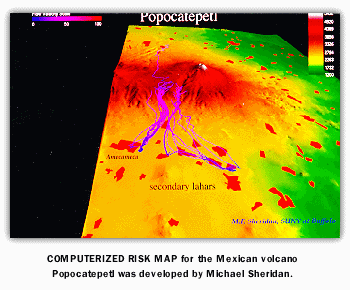

By ELLEN GOLDBAUM
News Services Editor
Public-safety officials in Mexico are making decisions about Popocatepetl, a towering volcano just 40 kilometers from Mexico City, based on a risk map designed using software that simulates volcano activity developed by researchers at UB.
The software can provide public-safety officials with more accurate information than may be available from fieldwork, and is useful particularly when fieldwork or historical data on a volcano is missing.
"This is a huge volcano surrounded by millions of people," explained Michael F. Sheridan, professor and chair of the Department of Geology at UB. "That makes Popocatepetl the riskiest volcano on the planet."
Sheridan developed the simulations with Hugo Delgado, associate researcher at the Geophysical Institute at the National University of Mexico in Mexico City.
Located just 40 kilometers from Mexico City and even closer to the city of Puebla (population: 2 million), Popocatepetl is one of the largest volcanoes in the world.
It also is the fifth highest mountain in North America, a feature that adds to its catastrophic potential.
Since a series of ash explosions that occurred in December, 1994, the volcano has gone through several stages of varying severity.
Last year, hikers from a prominent mountain-climbing organization scaled the volcano. While they were near the peak, the ash emissions suddenly and dramatically increased, killing five of the hikers.
In October, it seemed as though the volcano had entered a quieter period, but that period was followed by renewed explosions.
"An eruption is not inevitable," Sheridan stated, "but Popocatepetl is like a dusty champagne bottle sitting in a cellar. The activity may seem to be dying out, but the conduit through which gases could escape to the atmosphere is pretty plugged up right now. That allows pressure to build up and, if the underground chamber gets hot enough, the obstruction could be blasted away."
Earlier, the volcano began exhibiting tremors and renewed ash emissions marked by intermittent explosions.
"Reports of the end of this eruption have been greatly exaggerated," Sheridan declared.
Much new geologic information about Popocatepetl has been gathered in the past few years by researchers at the National University of Mexico.
That new information easily can be incorporated into the computer models, Sheridan said. "These models are well-suited for updating because they function like a spreadsheet," he said. "Results from new parameters can be calculated within a few seconds."
Developed by digitizing paper maps of the area, the colorful, animated simulations show the volcano and the surrounding area, with towns, villages and roads superimposed on it.
Using the simulations, the researchers can estimate how fast and how far lava flows from an eruption would travel and in which direction. They feed that data into computer models, from which they can calculate the probability that sliding material will destroy towns and roads. They take into account factors such as turbulence and viscosity of the flow, the coefficient of friction and the flow's starting velocity.
Because it is essentially a topographical map that has been digitized, the three-dimensional simulation also shows the precise form of the land in relief. The image can be manipulated to be viewed from any direction in real-time so that eruptions on any side are visible in three dimensions.
"From a management and public safety point of view, it's really important to have an accurate idea about where the flows will go and how fast," said Sheridan. "Without the aid of computer models, it's frustrating trying to predict where the hot flows would go."
For example, he said, if an evacuation is being considered, the map provides information that allows officials to decide which areas should be evacuated and which areas are safer.
